These sweet and flaky Eccles cakes are filled with the most delicious combination of currants, sugar and sweet spice. Serve these currant cakes as they are, or the traditional way – with a chunk of Lancashire cheese alongside. Either way, this Eccles cake recipe is a classic British tea-time bake not to miss out on.
Similar, but not the same, as these are Chorley cakes and Banbury cakes. I suggest you give them a try too.
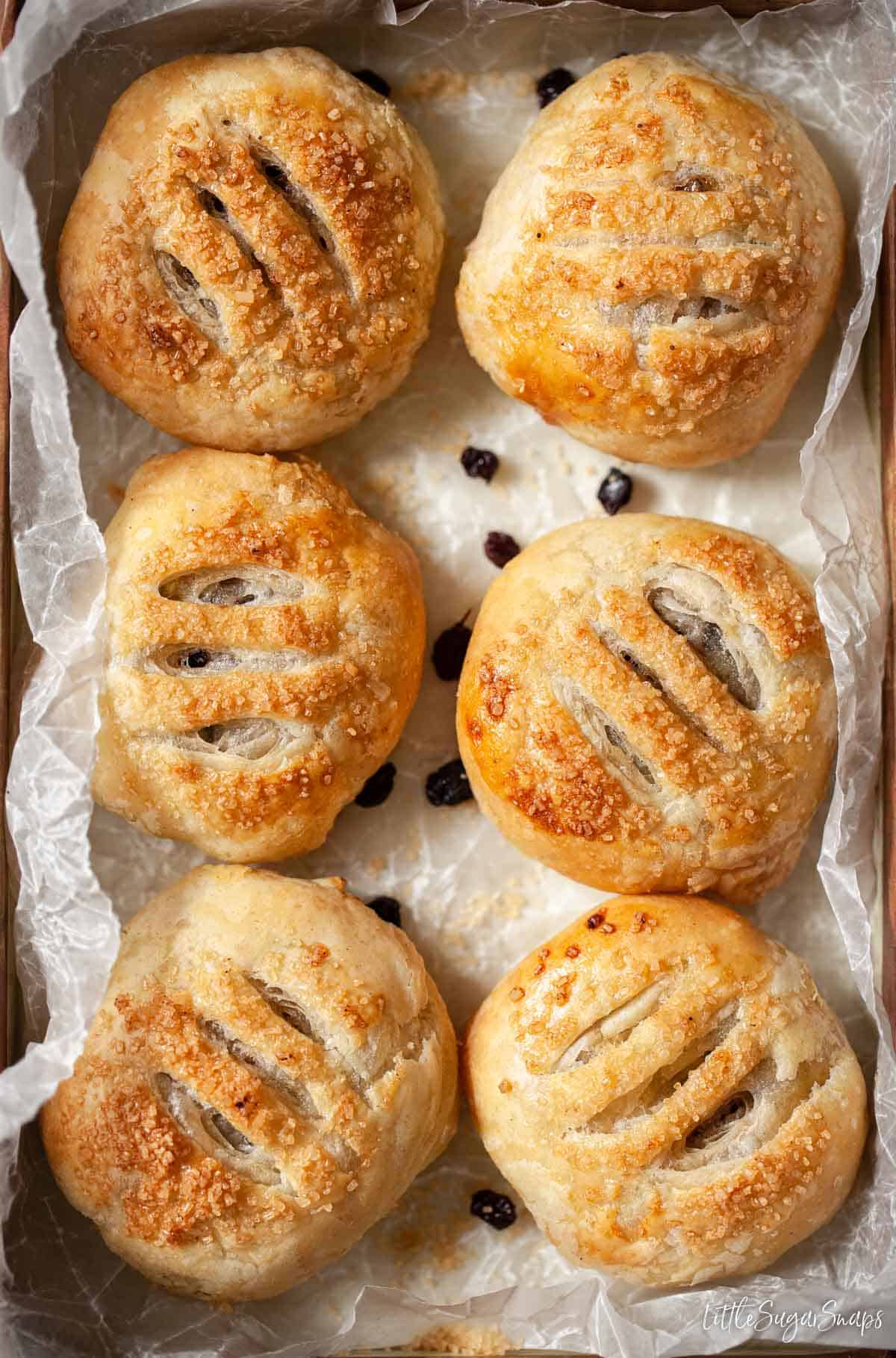
Want to Save This Recipe?
Jump to:
Eccles cakes are small, sweet round pastries filled with currants. Think of them as currant cakes. or currant pastries. They originate from the town of Eccles in Lancashire, England. They have been on the English food scene for over 200 years but are generally only spotted in tea shops in the North of England.
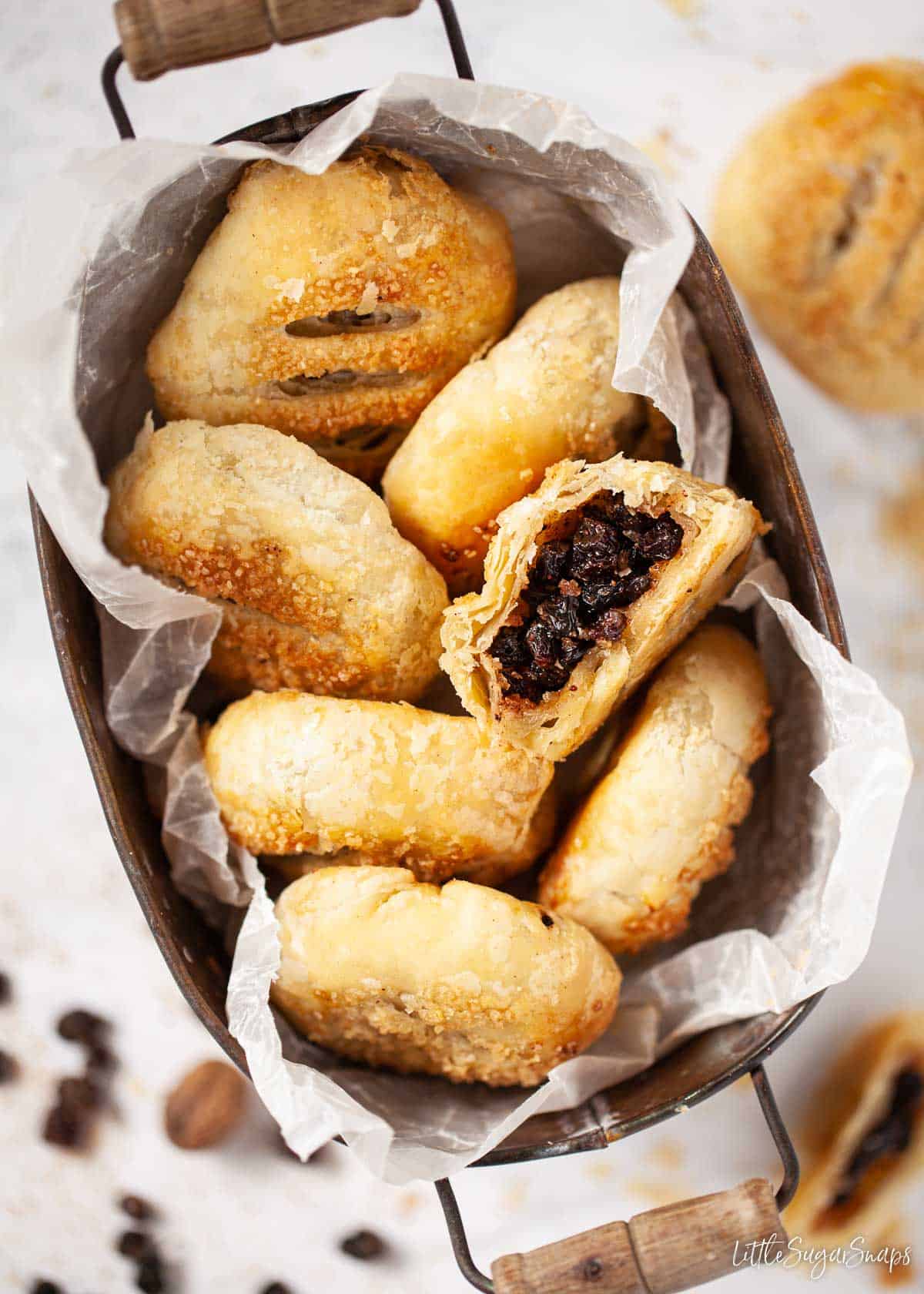
Why you’ll enjoy this bake
Moving attention back to the bake in hand today, two elements set this Eccles cake recipe up for success:
- Authentic flaky pastry: Flaky pastry is essential to this classic bake, helping to provide that crisp yet, for want of a better word, flaky shell that holds the filling together.
- A simple filling: at the heart of these humble Eccles cakes, is a delightfully rustic and simple centre. I’ve teamed the currants with demerara sugar, melted butter and a waft of sweet spice. Is this filling entirely traditional? That’s open to debate, but it’s definitely a winning formula all the same.
If you are in the minority who enjoys currants (I’m included in this group) then don’t miss my recipes for Belvoir Castle currant buns, soul cakes and baked suet pudding.
What are Eccles cakes made from?
Authentic Eccles cakes are made from flaky pastry and they should be stuffed to bursting-point with a mixture of currants and sugar.
Exactly what constitutes the authentic filling in traditional Eccles cakes is open to much debate. Some bakers assert that candied peel is essential. Others argue against. Some recipes feature spices and some do not. I guess that like with many age-old recipes, over the years individual bakers adopt their own renditions of the recipe according to their own tastes.
Eccles cakes were once banned by Puritans who considered them too indulgent. And they are sometimes referred to as “fly pies” due to the slits on top, reminiscent of the fly vents on old cottages.
Eccles cakes hold Protected Geographical Indication (PGI) status meaning they can only be called “Eccles cakes” if made in the traditional way and within a specific region.
Ingredients notes
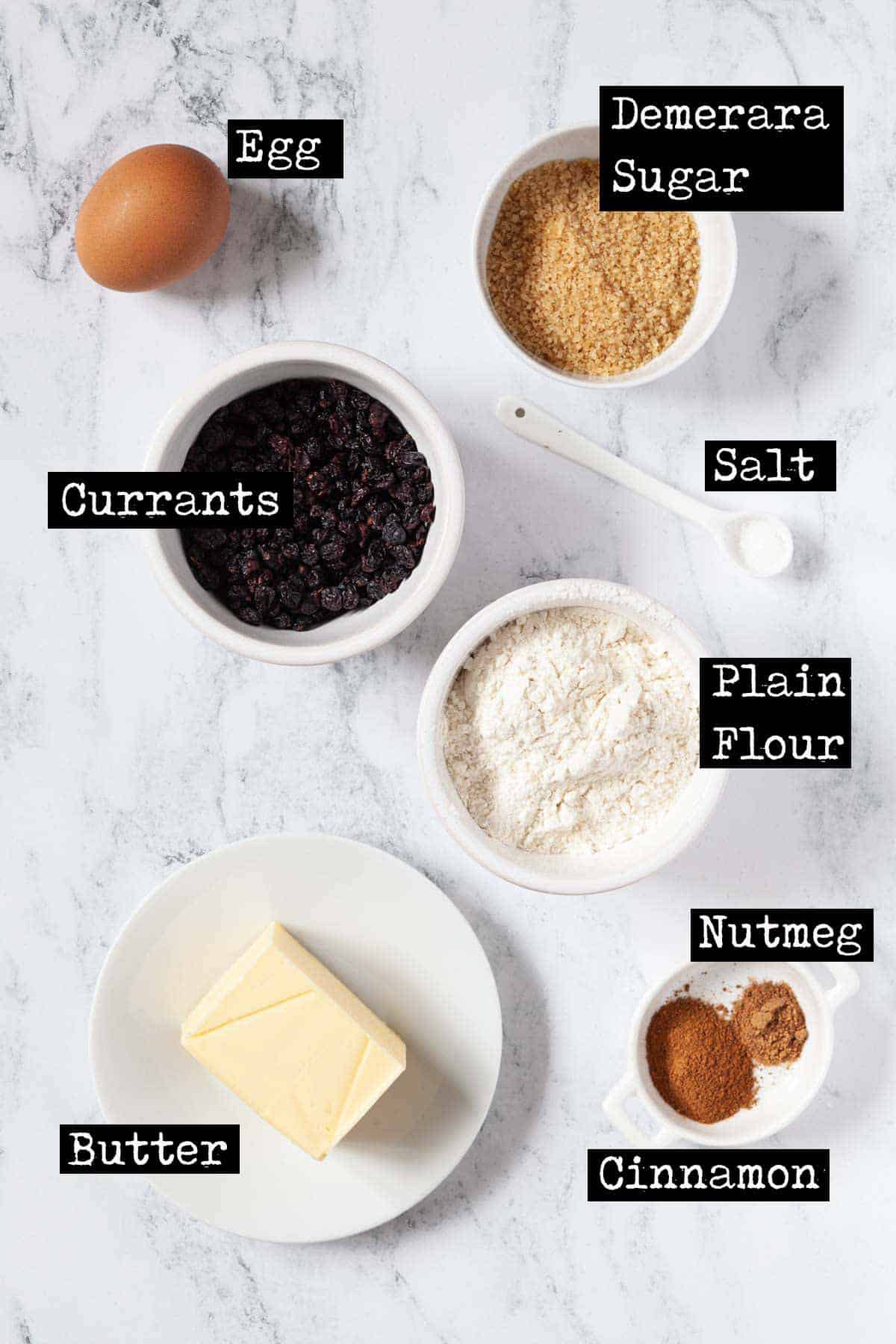
Currants: this ingredient is non-negotiable. Granted currants are not everybody’s first choice of dried fruit but in Eccles cakes, they shine. Do not be tempted to swap them for raisins or sultanas, you’ll be missing the point of Eccles cakes completely. And missing a treat.
I’ve recently discovered Vostizza currants (also available from M&S) which are soft and full-flavoured. I highly recommend them for this Eccles cakes recipe.
Demerara Sugar: this adds mellow sweetness and the coarseness of this sugar adds a charismatic crunch to the filling. There’s no substitute for this ingredient.
Spice: cinnamon and nutmeg are my spice preferences here, but if you want to leave them out or swap them for your favourite, that’s fine.
Butter: for the very best flaky pastry, only butter will do. It’s streaks ahead in terms of flavour compared to baking margarines. And the solid nature of chilled butter is essential when creating a crispy, flaky pastry.
Step by step instructions
Full instructions and measurements are given in the printable recipe card at the end of this post.
If you are new to making flaky pastry, fear not, I give full instructions before getting into the details of the recipe for these spiced currant cakes.
Stage 1: Make the Flaky Pastry
- Divide the butter into 4 portions.
- Put the flour and salt into a bowl and stir briefly then add 1 portion of the butter (cubed) and rub in.
- Pour in ¾ of the water and mix, with a blunt knife, to a soft dough, adding more water as necessary (do not add so much that the dough turns sticky.
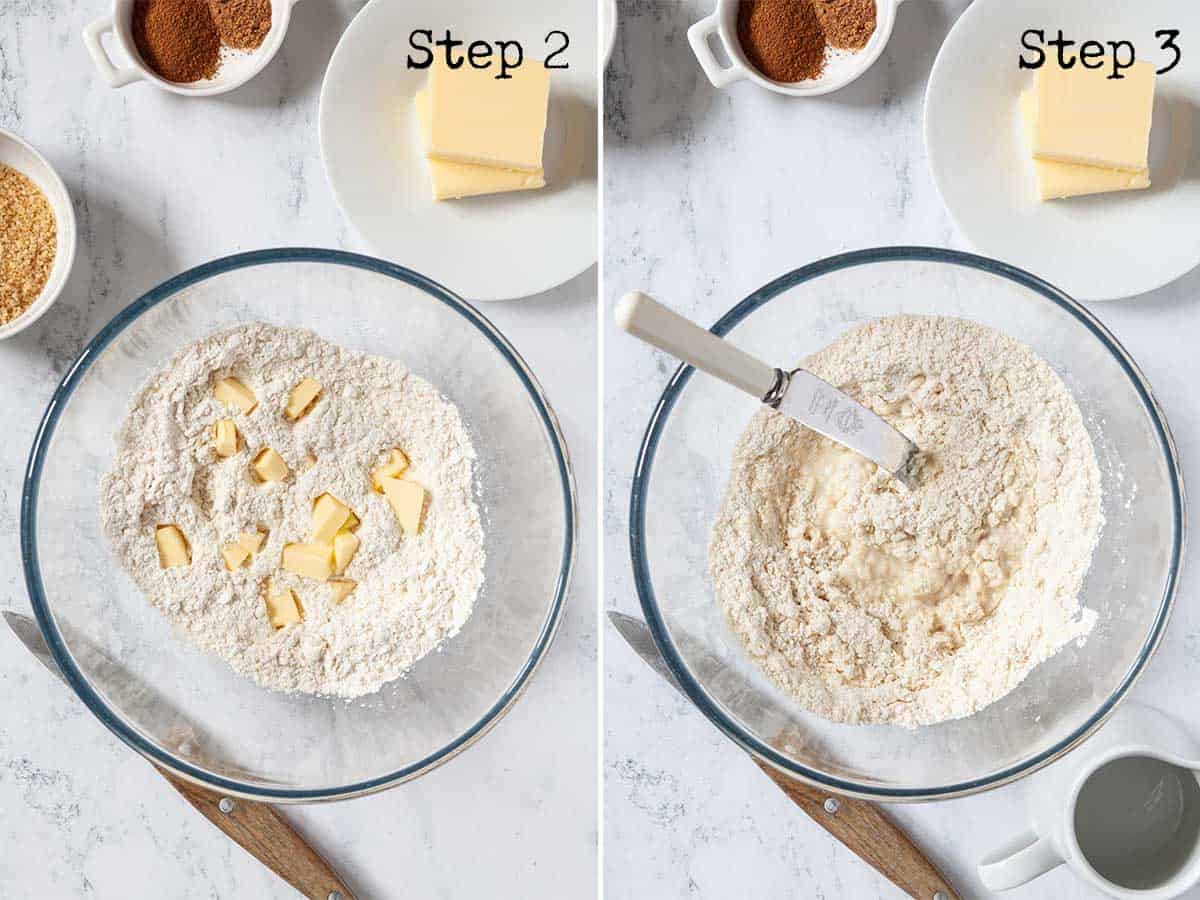
- Roll the dough into a long rectangle on a lightly floured worktop to approx 4mm thick. Take another portion of the butter, cube it and scatter over ⅔ of the dough, leaving the final ⅓ empty
- Fold the empty third of the dough over the top of the dough, bringing it to the centre
- Fold the other end of the pastry over the top, then rotate the pastry 90 degrees
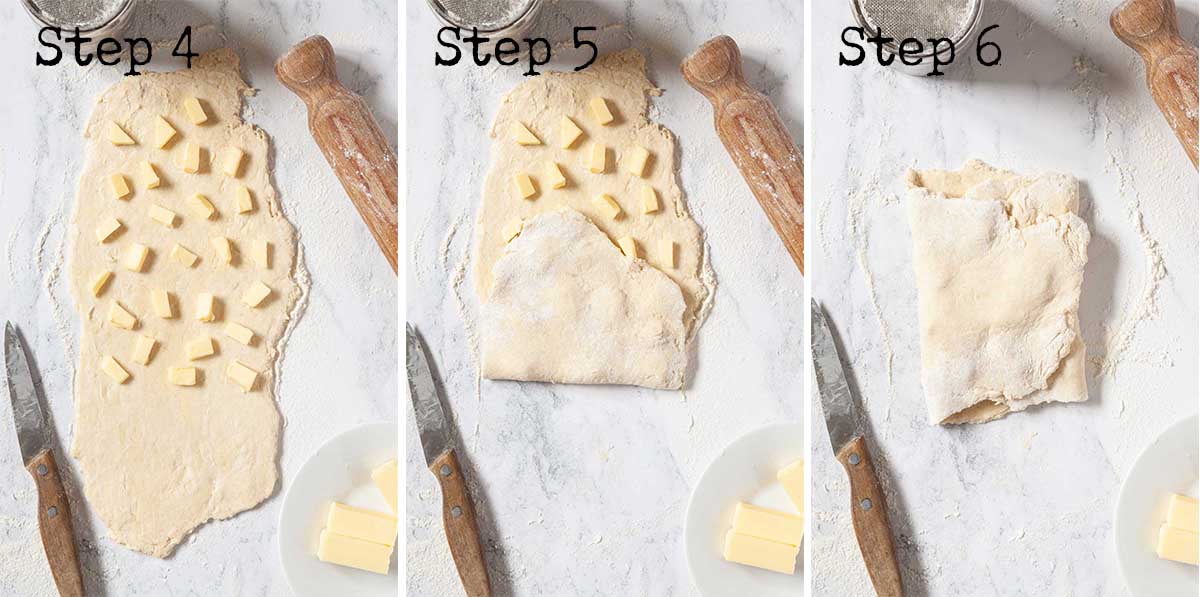
- Repeat steps 4-6 twice more to incorporate the remaining portions of butter.
- When all of the butter has been used, rotate the pastry and roll out once more, then fold it and wrap before chilling for 1 hour in the fridge.
Stage 2: Make the Eccles Cakes
- Reserve 2 teaspoon of the sugar for sprinkling then put the currants, spices and the remaining sugar into a small mixing bowl and stir briefly. Melt the butter, add to the bowl and mix again until the fruit is evenly coated.
- Roll the pastry out into a rectangle approx 18cm x 36 cm.
- Trim off any straggly edges then divide into 8 squares:
- First cut down the middle lengthwise.
- Then cut both strips in half widthwise. You now have 4 rectangles.
- Cut each rectangle in half widthwise to form a total of 8 approximate squares).
- Assemble the Eccles cakes as follows:
- (A) Divide all of the filling between the squares of pastry dough, using a spoon to pile it into the centre of each one.
- (B) Dip a finger in some cold water and run it around the edges of 1 square of pastry to dampen. Gather two opposite corners of pastry up towards the centre and press together lightly.
- (C) Gather the other corners up to the centre too, pushing the filling back into the centre as you do so, then gently press the pastry seams together (C).
- (D) Finally, draw the edges into the centre to form a circle. There should be no large gaps for the filling to leak out of.
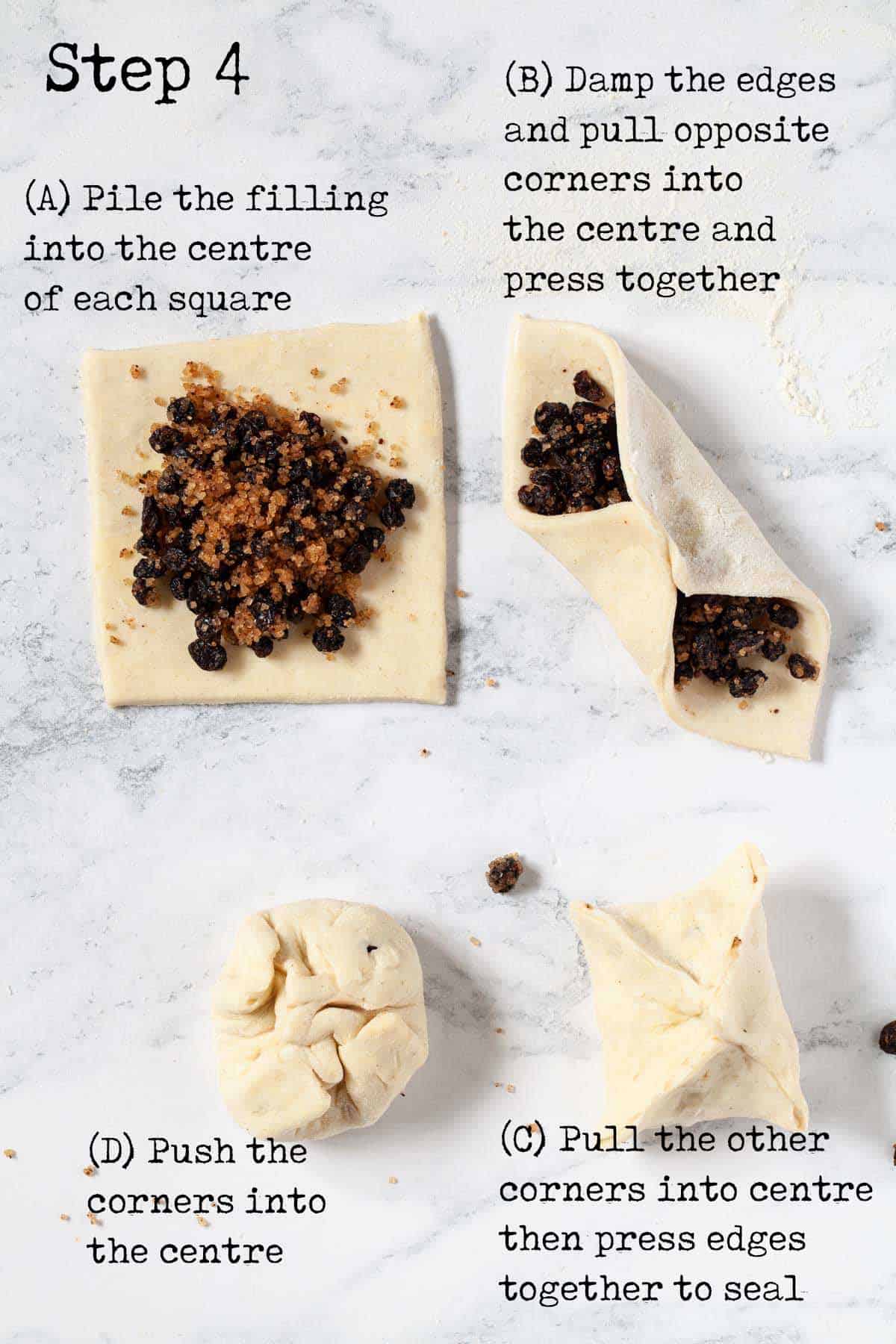
- Turn the pastry over, so the seams are underneath and use lightly floured hands to form a circular shape. Press down very gently to form a disc (do not press so much that the fruit breaks through the pastry).
- Repeat steps 4-5 with the remaining squares of dough, then brush the top of each cake with a little beaten egg and sprinkle the reserved sugar over the top. Use a sharp knife to cut three slashes across the top of each cake.
- Bake for 12-15 minutes until golden, then cool for a few minutes on a wire rack before devouring.

Expert tips
- Never skip the chilling of the pastry dough. It is easier to handle when sufficiently chilled and will bake to a superior texture.
- If making flaky pastry on a hot day, refrigerate the dough for 15 minutes each time another portion of butter is folded into it. And chill the assembled cakes for 20 minutes prior to baking. This is the best way to ensure the dough and butter stay cold enough to create a quality pastry.
- Ensure you roll your pastry to the right dimensions – 18 cm x 36cm – so that 8 squares can be cut from it.
- Each square will be approx 9×9 cm which is sufficient to hold the filling. When sealing each square, the filling will be a tight fit – this is exactly as it should be to ensure each currant cake is chock full of fruit once baked.
- Divide the filling evenly across all squares before beginning to seal any of them ensuring that all of the filling is used.
- Seal one square at a time to avoid the water drying out/ turning the pastry soggy.
- When sealing the pastry, some of the filling will fall out – push it back in and continue to seal, leaving no gaps.
- Once sealed and shaped, do not press down too firmly to flatten – the currants should not poke through the dough.
- Do not reheat your Eccles cakes in the microwave. For one thing, it will ruin that beautiful flaky pastry, rendering it soggy. But apparently, the sugar coating on the outside of these little delights can catch fire when reheated in the microwave. Go for 5 minutes in the oven at 150C/ 300F/ GM 2 instead and live to tell the tale.
Frequently asked questions
Eccles cakes should not be confused with Chorley cakes. Although they are similar, there are a couple of differences. Chorley cakes are made from shortcrust pastry and they are less sweet than Eccles cakes.
These currant cakes are utterly delicious when still slightly warm, but cold is fine too. Eccles cakes are traditionally served either just as they are or with a wedge of Lancashire cheese, so put aside the custard and cream for this recipe.
Eccles cakes can be stored at room temperature (in an airtight tin) for 24 hours but are best eaten as fresh as possible.
Eccles cakes can be frozen either before or after baking.
Simply prepare fully, up to, and including, the point of adding the egg wash and sugar topping if choosing to freeze before baking. Open-freeze them on a baking sheet lined with parchment and, when solid, slide them into a freezer container or bag. Label them and keep frozen for up to 2 months. Bake from frozen by laying them onto a lined baking sheet and cooking for 20-25 minutes at the temperature specified in the recipe card below.
If already cooked, let them cool completely and freeze as soon as possible. Let defrost fully, then reheat for 5-10 minutes to re-crisp the pastry.
I honestly do not recommend this substitution. It’s just not in the spirit of the Eccles cake.
I know that currants often get a bad press, and, I’ll happily confess that they are not my favourite dried fruit. However, I urge you to give the traditional filling a go. You may just be surprised how well the currants work in this Eccles cake recipe.
If you fall short of time or just do not enjoy making pastry then opt for store-bought pastry. Flaky is by far the best option for Eccles cakes, but if you struggle to find any, then puff pastry is the next best alternative.
Avoid using shortcrust pastry as this will not result in the flaky texture associated with Eccles cakes (it will be more like a Chorley cake).
Yes, you can. You’ll need to use gluten-free flaky pastry to do so
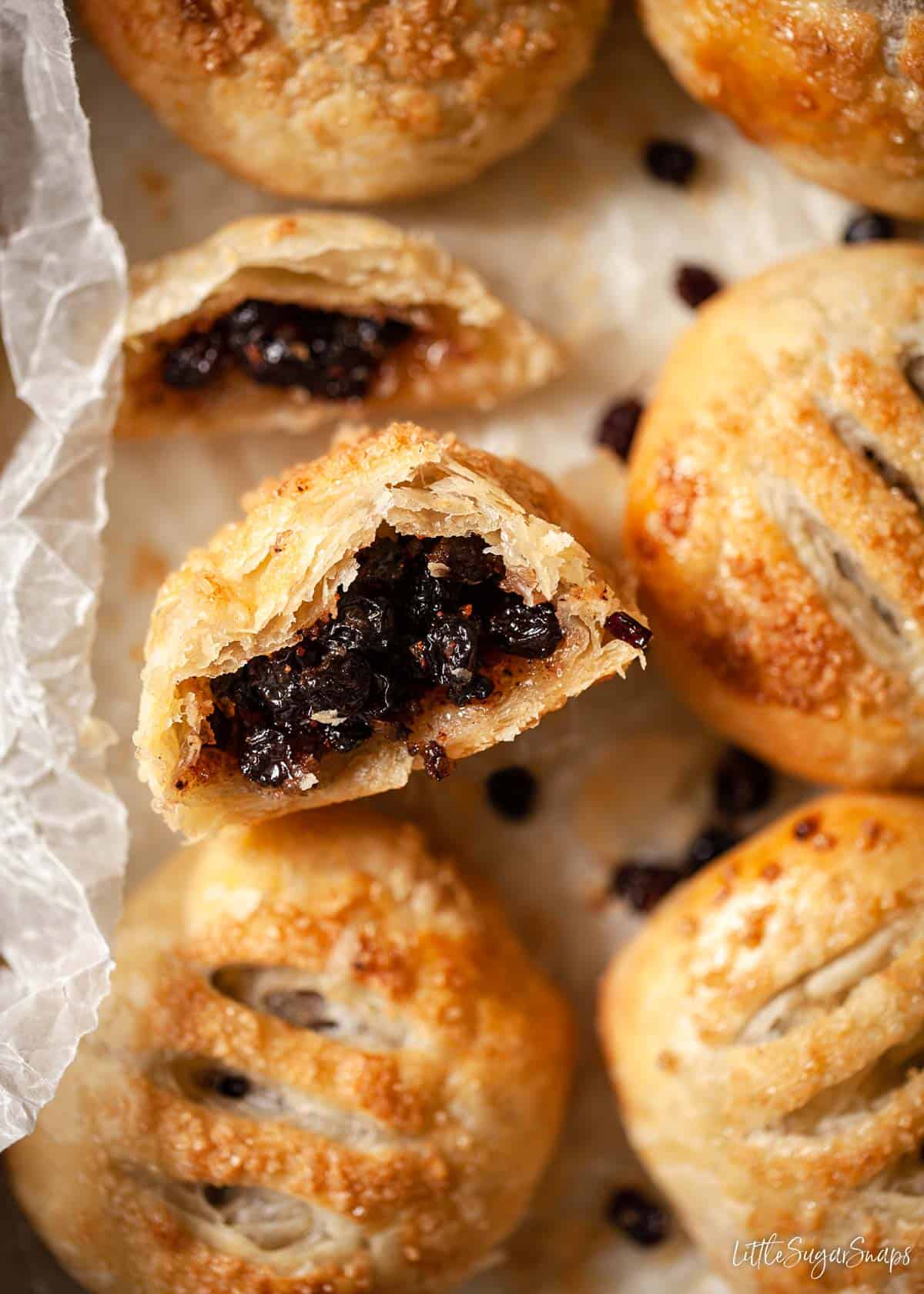
Variations
Take a look in cookbooks and at recipes online and it’s plain to see that there are plenty of opinions on what a good currant cake should include. If you feel like switching things up in this Eccles cake recipe, try the following ideas:
- Candied citrus peel: replace 15g (½ oz) of the currants with finely diced candied peel.
- Fresh zest: add the zest of an orange or lemon to the fruit mix.
- No spice: just leave them out.
- More spice: add in ¼ teaspoon allspice and/ or ½ teaspoon ginger alongside the cinnamon and nutmeg.
- Get festive: for a Christmassy twist replace 50g (1 ½ oz) of the currants with mincemeat – use your fingers to rub the mincemeat into the sugar.
More dried fruit recipes to try
Have you made this Eccles cake recipe? Please give it a rating below. Don’t forget to share your creations with me on Instagram too – I love to hear how you’ve got along. Use #littlesugarsnaps and tag me @jane_littlesugarsnaps.
Stay in touch: sign up to receive LittleSugarSnaps newsletters to hear when new recipes are published. Or follow me on social media:
📖 Recipe
Want to Save This Recipe?
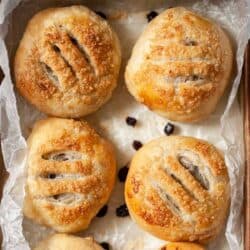
Eccles Cakes with Cinnamon and Nutmeg
Ingredients
Flaky Pastry
- 115 g Plain flour all-purpose
- 85 g Butter chilled
- ⅛ teaspoon Salt
- 75 ml Water ice cold
Filling
- 100 g Currants
- 60 g Demerara sugar
- ¾ teaspoon Ground cinnamon
- ¼ teaspoon Ground nutmeg
- 15 g Butter
- A little beaten egg for glazing
Instructions
Make the Flaky pastry
- Divide the butter into 4 portions
- Put the flour and salt into a bowl and stir briefly. Cube 1 portion of the butter, add to the bowl and rub in
- Pour in ¾ of the water and mix, with a blunt knife, to a soft dough, adding more water as necessary (do not add so much that the dough turns sticky)
- On a lightly floured worktop roll the dough into a long rectangle approx 4mm thick. Take another portion of the butter, cube it and scatter over ⅔ of the dough, leaving the final ⅓ empty
- Fold the empty third of the dough over the top of the buttered dough, bringing it to the centre . Then fold the other end of the butter-topped pastry over the top too
- Rotate the pastry 90 degrees and repeat steps 2 and 3. Rotate once more and repeat again. All 4 portions of butter should now be incorporated into the pastry dough
- Rotate the pastry and roll out once more, then fold it and wrap before chilling for 1 hour in the fridge
Assembling the Eccles Cakes
- Preheat the oven to 200C/ 400F/ GM 6 and line a baking sheet with baking parchment
- Reserve 2 teaspoon of the sugar for sprinkling
- Put the currants, spices and the remaining sugar into a small mixing bowl and stir briefly. Melt the butter, add to the bowl and mix again until the fruit is evenly coated
- Roll the pastry out into a rectangle approx 18cm x 36 cm. Trim off any straggly edges then divide into 8 squares. (First cut down the middle lengthwise then cut both strips in half widthwise. You now have 4 rectangles. Cut each rectangle in half widthwise to form 8 approximate squares)
- Divide all of the filling between the squares of pastry dough, using a spoon to pile it into the centre of each one
- Dip a finger in some cold water and run it around the edges of 1 square of pastry to dampen. Gather two opposite corners of pastry up towards the centre and press together lightly. Gather the other corners up to the centre too, pushing the filling back into the centre as you do so. When all corners are gathered gently press the pastry seams together and draw the edges into the centre to form a circle
- When you are certain all edges are sealed, turn the pastry over, so the seams are underneath and use lightly floured hands to form a circular shape. Press down very gently to form a disc (do not press so much that the fruit breaks through the pastry)
- Repeat steps 6-7 with the remaining squares of dough
- Brush each top with a little beaten egg and sprinkle the reserved sugar over the top. Use a sharp knife to cut three slashes across the top of each cake
- Bake for 12-15 minutes until golden
Notes
Baking Tips
- Never skip the chilling of the pastry dough. It is easier to handle when sufficiently chilled and will bake to a superior texture
- If making flaky pastry on a hot day, refrigerate the pastry for 15 minutes each time anther portion of butter is folded into the dough. And chill the assembled cakes for 20 minutes prior to baking. This is the best way to ensure the dough and butter stays cold enough to create a quality pastry
- Ensure you roll your pastry to the right dimensions – 18 cm x 36cm – so that 8 squares can be cut from it. It will be approx 3-4 mm thick
- Each square will be approx 9×9 cm which is sufficient to hold the filling. When sealing each square, the filling will be a tight fit – this is exactly as it should be to ensure each Eccles cake is chock full of fruit once baked
- Divide the filling evenly across all squares before beginning to seal any of them. This ensures that all of the filling is used
- Seal one square at a time to avoid the water drying out/ turning the pastry soggy
- It is normal for some of the filling to fall out when sealing the pastry. Just push it back in and continue to seal, leaving no gaps for it to leak out of
- The bottom of each cake might look rustic, but once baked, nobody will notice. It’s more important to achieve a tight seal than to have a neat bottom
Using Pre-made Pastry
If you fall short of time or just do not enjoy making pastry then opt for store-bought pastry. Flaky is by far the best option for Eccles cakes, but if you struggle to find any, then puff pastry is the next best alternative. You’ll need approx 300g Avoid using shortcrust pastry as this will not result in the flaky texture associated with Eccles cakes (it will be more like a Chorley cake).Reheating instructions
Eccles cakes can be eaten cold, but they are particularly delicious warm. If you need to reheat yours, do so in an oven pre-heated to 150C/ 300F/ GM 2 for around 5 minutes. This is the best way to ensure that the pastry stays flaky. Never reheat your Eccles cake in the microwave. For one thing, it will ruin that beautiful flaky pastry, rendering it soggy. In addition, the sugar coating on the outside of these pastries can catch fire when reheated in the microwave.Freezing Instructions
Eccles cakes can be frozen either before or after baking. If choosing to freeze before baking, simply prepare right up to, and including, step 9 in this recipe card then open freeze the pastries on a baking sheet lined with parchment. When frozen solid, slide into a freezer container or bag, label and keep frozen for up to 2 months. Bake from frozen by laying onto a lined baking sheet and cooking for 20-25 minutes at the temperature specified in the recipe card above. If already cooked, let cool completely and freeze as soon as possible. Let defrost fully, then reheat for 5-10 minutes to re-crisp the pastry.Nutrition Per Serving (Approximate)
Have you made this recipe for ***? I’d love to hear how you got along with it, so please rate the recipe or leave a comment below.
Have you made this recipe for ***? I’d love to hear how you got along with it, so please rate the recipe or leave a comment below.

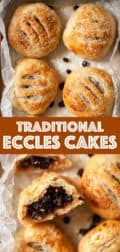
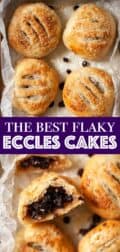
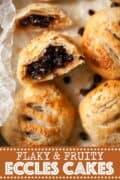
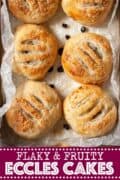
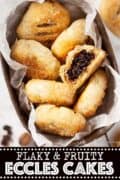
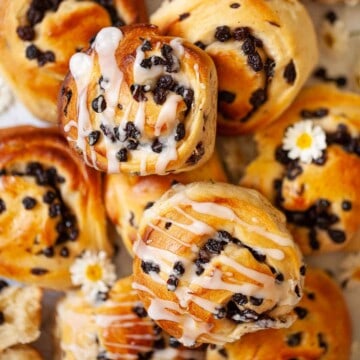
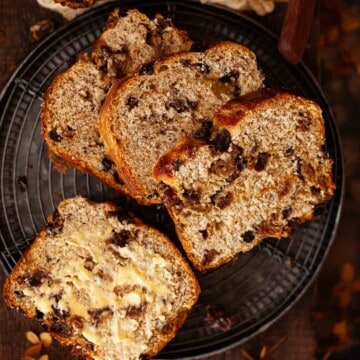
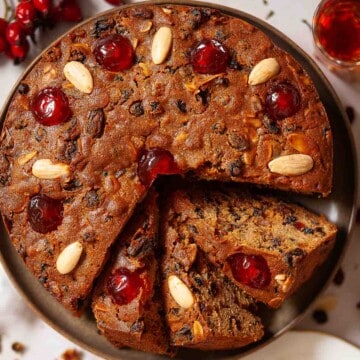
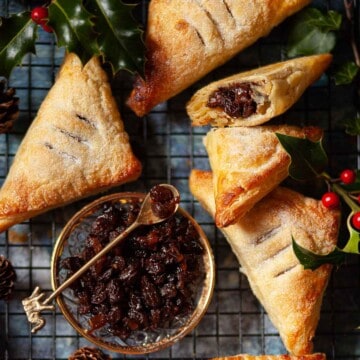
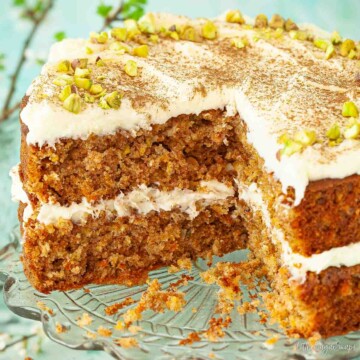
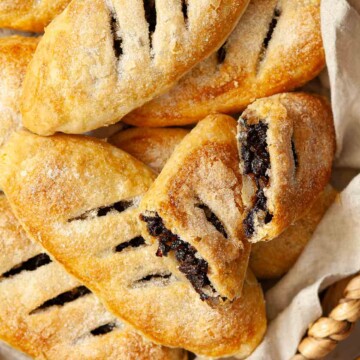
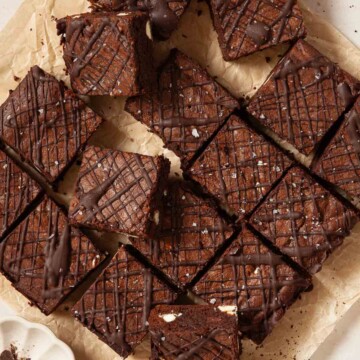
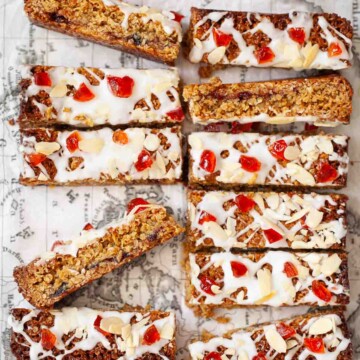
Pam
I have to admit I have never heard of these delightful little cakes. I love learning about new food traditions and can’t wait to try them!
Jane Saunders
They are very British, but utterley delightful. Hope you enjoy them.
Amanda Wren-Grimwood
I’ve not had an eccles cake in years and you’ve reminded me how good they are. Love your instructions for the flaky pastry too – i can’t go wrong now!
Jane Saunders
Glad to be of help – hope you enjoy them as much as you remember them to be.
Claudia Lamascolo
I just love the flavors in this how so delicious! We just love flaky pastry! bravo!
Jane Saunders
Thanks Claudia
Helen
I haven’t made Eccles cakes for ages – funnily enough, it was my Dad who was the big Eccles cake lover in our family too! I’m really craving one now though. YUM!
Jane Saunders
Treat yourself – that’s all I can say. You won’t regret it 😉
Jane Saunders
These Dads – they know when they’re onto a good thing!